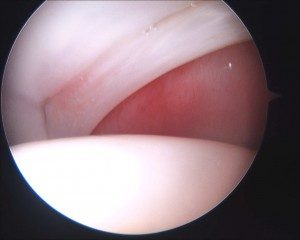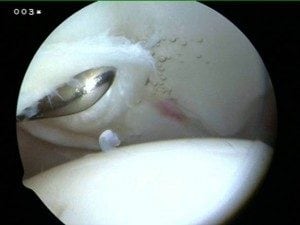What is Arthroscopic Surgery?
Quite simply, this is surgery for a joint disorder (knee, shoulder, ankle, etc.) done through small incisions (portals) with the assistance of a camera (an “arthroscope”) and other minimally invasive instruments.
The advantage of this type of surgery is that it allows the surgeon access to the joint with minimal disruption of skin, muscle and other soft tissues. Blood loss is significantly less than with open surgery and often there is a much quicker recovery.
Arthroscopic surgery of the knee and shoulder have been extremely effective for patients over the past three decades. Common conditions treated are ligament ruptures, meniscal pathology and rotator cuff tears.
Improving Treatment Options for Hip Pain
In the past, hip surgery has typically been done in an “open” fashion with large incisions and longer recovery times. The reason for this is that arthroscopic surgery of the hip is much more technically challenging than in the knee or shoulder. The hip joint is “deeper” within the body and working space is much more limited. It was felt that many hip disorders were not amenable to surgical treatment. Often, patients were forced to either live with hip pain or consider total joint replacement at a young age.

Arthroscopic view of the normal acetabular labrum of the hip
In the last ten years, a small group of arthroscopic surgeons have worked to bring arthroscopic solutions to many hip disorders. This has dramatically increased treatment options available to patients with hip pain.
Bringing Advancement in Hip Arthroscopy to Richmond, VA
Dr. Wind was fortunate enough to be exposed to hip arthroscopy during his training. He has also traveled around the country to gain advanced training in new arthroscopic techniques for the hip. Bringing these skills to Richmond, Dr. Wind now has the highest volume hip arthroscopy practice in central Virginia.
Common hip conditions treated by Dr. Wind include labral tears of the hip, femoroacetabular impingement, chondral (cartilage) lesions, snapping iliopsoas tendinitis and intra-articular loose bodies.

Probing of acetabular labral tear
Frequently Asked Questions about Arthroscopic Hip Surgery
Q: Will I need to be admitted to the hospital after arthroscopic hip surgery or can I go home that day?
The vast majority of hip arthroscopy patients are able to go home the same day of surgery. Most of these procedures are performed at outpatient surgery centers and do not involve any hospital stay
Q: How is the surgery performed? How does the surgeon access the hip joint?
The surgery requires general anesthesia and a specialized OR table which is called a Hana Table. This table is available at the OrthoVirginia Shrader Road Operatory. The table allows the surgeon to place gentle traction on the operative leg which opens the hip joint just enough to allow access with an arthroscope. The image of the hip is displayed on a high-definition screen in the operating room. Once inside the hip the surgeon can diagnose the problem and place other small incisions or “portals” to allow other instruments access to the hip. Most cases involve 2-4 portals into the hip. Through these access points, the surgeon can then address the underlying problem. Common procedures performed included labral repair, osteoplasty for the treatment of femoroacetabular impingement (FAI), removal of loose bodies of the hip, and debridement of cartilage tears.
Q: Can I put weight on my leg after surgery?
This depends on what is done during the surgery. If the surgery involves simple debridement of a labral tear then the patient would be allowed to weight bear as tolerated after surgery with crutches for comfort. If the surgery involves repair of the labrum or shaving of the bone (osteoplasty) for the treatment of impingement then there is usually a period of 4-6 weeks where the patient must keep the majority of their weight off of the operative leg.
Q: Will I have sutures (“stitches”) to remove after surgery?
Yes, most patients will have one or two simple sutures in each of the portals sites that will be removed by the physical therapist approximately 10 days postoperatively
Q: When can I return to work after surgery?
This depends on the procedures performed during surgery as well as the nature of your job. In most cases, patients can return to desk work duties within a week of surgery. For jobs that involve manual labor then this time can be much longer
